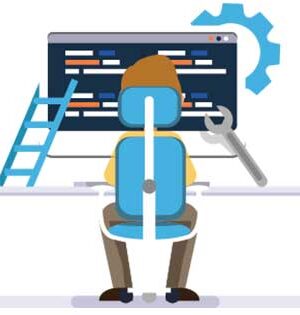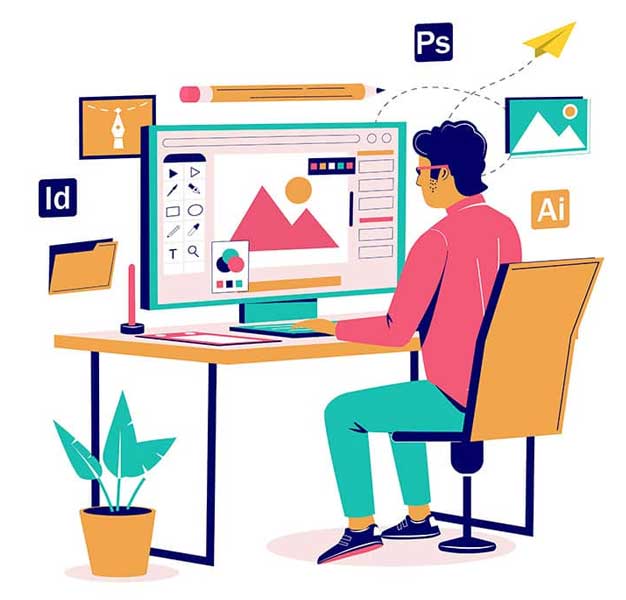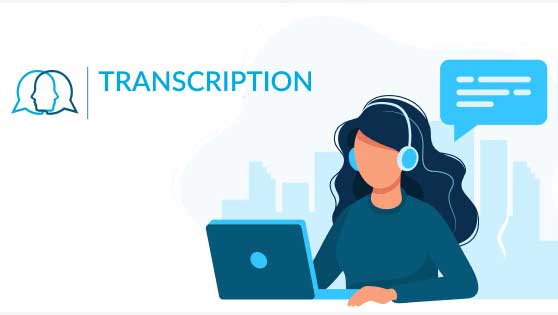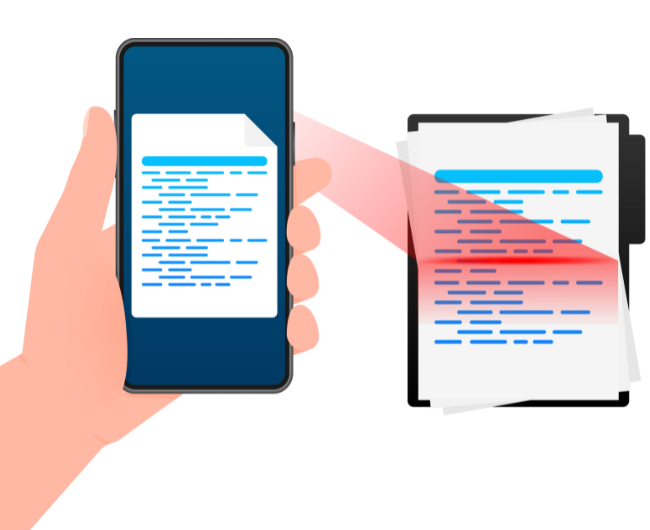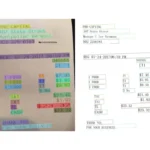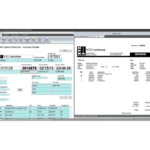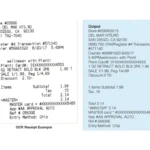

OPTICAL CHARACTER RECOGNITION SERVICE
Optical Character Recognition (OCR) services are revolutionizing the way businesses handle data by converting printed or handwritten text from documents, images, and PDFs into machine-readable digital formats. This automated technology increases efficiency by eliminating manual data entry, enabling swift data processing for high volumes of documents. OCR is especially valuable in industries such as finance, healthcare, and logistics, where timely data extraction is critical for operations.
An OCR service transforms diverse document types, from invoices and contracts to handwritten notes and scanned forms, making information searchable and easily accessible. Advanced OCR systems now incorporate AI and machine learning to improve accuracy in complex documents, handling everything from mixed languages to intricate layouts and fonts. This adaptability has made OCR a go-to solution for companies looking to digitize their records.
Beyond text extraction, modern OCR solutions integrate with other software, allowing seamless data flow across platforms like enterprise resource planning (ERP) systems and customer relationship management (CRM) tools. For example, OCR engines can automatically update records in real time, accelerating workflows and reducing manual errors. This integration capability allows businesses to optimize operational processes.
For industries that rely on paper-based data or have high data processing needs, OCR services can significantly reduce operational costs. By automating data conversion, companies save on manual labor and increase productivity, freeing up employees to focus on higher-level tasks. OCR services also support compliance by ensuring data is consistently digitized, indexed, and accessible, which is essential for audits and regulatory reporting.
OUR PROCESS

CALCULATOR
PORTFOLIO
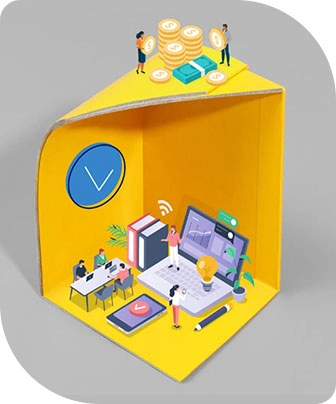
Save time & money
Getting quality outsourcing services does not have to be time taking and we help our customers save time and cost through magnificient outsourcing services.
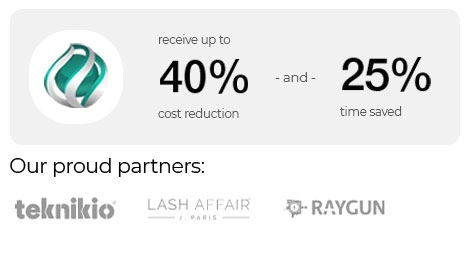

Save time & money
Getting quality outsourcing services does not have to be time taking and we help our customers save time and cost through magnificient outsourcing services.
Happy Clients
Projects Completed
Resource Strength
Work Experience
Introduction to Optical Character Recognition (OCR) Service
Optical Character Recognition (OCR) services are transforming industries by enabling digital access to physical data. OCR technology convert image to text, extract text from pdf, and paper documents into editable, searchable digital text, enhancing data accessibility and workflow efficiency. Optical Character Recognition is invaluable for businesses that process large volumes of documents or rely on information extracted from printed materials. This article delves into the applications, technologies, and industries benefiting from Optical Character Recognition, demonstrating why it’s a key tool in modern data processing.
What is Optical Character Recognition (OCR)?
OCR, or Optical Character Recognition, is a technology that extracts text from images, printed papers, and scanned documents, transforming them into machine-readable digital formats. By eliminating manual data entry, OCR services improve data accuracy and automated document processing speed, helping businesses manage and analyze their information efficiently. Advanced Optical Character Recognition algorithms can now recognize various languages and handwriting styles, making the technology accessible for a diverse range of uses.
How OCR Technology Works?
Handwriting recognition OCR technology functions by analyzing a document’s structure and identifying characters, words, and sentences. Modern online OCR service systems utilize machine learning and deep neural networks to improve text recognition accuracy, even with complex fonts or low-quality images. Some Optical Character Recognition systems, like ABBYY FineReader or Google Vision, employ AI document recognition technology to handle challenging layouts or handwriting, improving overall efficiency for businesses.
Applications of OCR Across Various Industries
Following are the Optical Character Recognition applications that will help your businesses: OCR in Healthcare: Healthcare relies heavily on document digitization for patient records, prescriptions, and medical reports. Document Digitization services streamline these processes, ensuring quick retrieval of patient data, which is critical for quality patient care. Optical Character Recognition also enhances compliance by creating secure, searchable electronic health records (EHRs). Optical Character Recognition in Financial Services: Financial institutions use Optical Character Recognition to digitize documents such as invoices, checks, and loan applications. By automating data extraction, OCR improves financial workflows, reduces processing time, and enables more accurate audits. OCR also supports compliance with financial regulations by digitizing and securely storing important documents. OCR in Legal and Compliance: In legal services, Optical Character Recognition is instrumental for digitizing case files, contracts, and other legal documents. This data extraction service enables legal professionals to quickly search and cross-reference documents, ensuring efficiency in document management and helping firms maintain compliance with data storage regulations.
Types of Optical Character Recognition Technology
Following are the types of Optical Character Recognition Technology: Traditional Optical Character Recognition: Traditional Optical Character Recognition relies on basic pattern recognition to interpret printed text. Although effective for standard fonts and layouts, it may struggle with complex documents or handwriting. AI-Powered Optical Character Recognition: AI-powered OCR uses machine learning algorithms to improve accuracy, even for complex layouts or low-quality images. These systems adapt over time, learning to recognize new characters and formats, making them more versatile for diverse applications.... Handwriting Recognition Optical Character Recognition: Handwriting Optical Character Recognition is a specialized technology for interpreting cursive or printed handwriting. It’s particularly useful in digitizing forms or historical documents, where typed text isn’t always available. Key Benefits of Optical Character Recognition Services: Following are the key benefits of OCT Services: 1. Enhanced Data Accessibility and Searchability: Automated data extraction solution services make printed information instantly searchable and editable. By digitizing content, Optical Character Recognition enables users to quickly locate and retrieve specific information, supporting better data organization. This feature is crucial for industries with extensive archives or those that require rapid access to information, such as healthcare and finance. 2. Cost and Time Savings: Implementing image to text conversion technology reduces the need for manual data entry, which can be both time-consuming and costly. Automated text recognition ensures faster processing times for documents and significantly lowers operational costs, allowing employees to focus on higher-value tasks. 3. Increased Accuracy and Data Integrity: OCR services minimize human error in data processing by automating extraction and digitization tasks. Advanced OCR solutions maintain high accuracy levels, even for complex documents, preserving data integrity and ensuring reliable information storage. Choosing the Right Optical Character Recognition Service Provider When selecting an OCR service providers, consider factors like accuracy, language support, integration capabilities, and scalability. Leading providers, including Amazon Textract, ABBYY FineReader, and Nanonets, offer robust solutions with features tailored for specific industry needs. Integration capabilities are also essential, allowing optical text recognition systems to seamlessly connect with enterprise platforms like ERP and CRM, further automating workflows and enhancing efficiency. Best Practices for Optical Character Recognition Implementation: Implementing OCR effectively involves selecting high-quality images, configuring the Optical Character Recognition engine for specific tasks, and ensuring robust error correction mechanisms. These practices improve OCR accuracy and reliability, especially in industries where data quality is critical. Periodic system updates and ongoing training of AI-powered OCR solutions help maintain accuracy as document types evolve. The Future of Optical Character Recognition Technology: OCR for large scale document management technology is advancing with innovations like deep learning and natural language processing, enhancing its capabilities beyond simple text extraction. Future OCR solutions are expected to offer better language support, faster processing speeds, and increased accuracy for complex documents. Emerging technologies like Transformers—an advanced machine learning model—allow Optical Character Recognition to interpret text more contextually, which could transform document digitization. Final Thoughts on the Power of Optical Character Recognition in Modern Data Management: Document procession automation services provide indispensable solutions for businesses seeking to streamline document management, improve data accessibility, and enhance productivity. From converting images to text to supporting complex legal and financial document processing, Optical Character Recognition is a key asset for organizations aiming to digitize and automate workflows. By choosing the right OCR provider and leveraging advanced technologies, companies can unlock the full potential of Optical Character Recognition, optimizing operations and future-proofing data management processes.

How accurate is Optical Character Recognition technology?
The accuracy of Optical Character Recognition technology depends on several factors, including the quality of the scanned document, the OCR software used, and the complexity of the document layout. High-quality images with clear text typically yield an accuracy rate of around 98-99% for advanced OCR solutions. For complex layouts, AI-powered Optical Character Recognition systems with machine learning algorithms improve accuracy, especially for non-standard fonts or handwritten text.
Can Optical Character Recognition read handwriting?
Yes, some Optical Character Recognition systems can read handwriting, but it can be more challenging than reading printed text. This type of Optical Character Recognition is known as ICR (Intelligent Character Recognition) and is effective for structured handwriting, such as forms. However, it may struggle with cursive handwriting or messy text. Advances in AI have improved handwriting recognition, though accuracy still varies based on the writing style and quality of the document.
What are the main benefits of using Optical Character Recognition?
Optical Character Recognition offers several benefits, including improved accessibility of information, reduced data entry costs, and faster processing times for large volumes of documents. OCR technology can also increase data accuracy, make information searchable, and support compliance by creating digitized, easy-to-store copies of documents. These benefits are particularly valuable for industries like healthcare, finance, and legal services.
How is Optical Character Recognition used in different industries?
Optical Character Recognition is used across various industries to improve data processing and storage. In healthcare, Optical Character Recognition digitizes patient records for better accessibility. Financial institutions use OCR for document processing, like extracting data from checks or invoices. The legal industry uses Optical Character Recognition for managing case files and contracts. Optical Character Recognition applications also extend to education, logistics, and government sectors, where large amounts of printed data need to be managed efficiently.
Can Optical Character Recognition software recognize text in multiple languages?
Yes, many OCR solutions support multiple languages. Advanced OCR systems use machine learning to recognize characters and text in various languages, including non-Latin scripts like Arabic, Chinese, or Cyrillic. When choosing an Optical Character Recognition service, it’s essential to check if the software supports the specific language required, as not all Optical Character Recognition tools offer universal language support.
What types of files are compatible with Optical Character Recognition software?
OCR software can process various file types, including PDF, JPEG, PNG, TIFF, and BMP. Most Optical Character Recognition tools accept both scanned documents and images taken with a camera, provided the text is clear and readable. Some advanced Optical Character Recognition systems can also handle complex documents like multi-page PDFs, and they allow batch processing for handling multiple files at once.
Is OCR technology secure?
OCR technology itself is secure, but the data it processes may require additional security measures, especially in sensitive industries like healthcare and finance. Many OCR providers offer encryption and secure cloud storage options to protect sensitive data. When using OCR services, ensure that the provider follows data privacy regulations like GDPR or HIPAA if applicable.
How can OCR improve business workflows?
Extract text from PDF streamlines workflows by converting physical documents into digital files, reducing the need for manual data entry and allowing faster access to information. By integrating with enterprise systems such as ERP or CRM, convert image to text technology can automate data entry, making document management more efficient. This automation helps businesses reduce operational costs, minimize errors, and improve productivity.
What is the difference between OCR and AI OCR?
Traditional OCR for large scale document management uses basic pattern recognition to identify text, which works well for standard fonts and simple layouts. AI document recognition technology, however, uses artificial intelligence and machine learning to recognize complex layouts, handwriting, and even non-standard fonts with higher accuracy. AI-powered OCR also learns and adapts over time, improving its performance with continuous use.
What types of documents are best suited for Optical Character Recognition?
Automated data extraction solutions work well with printed documents, scanned images, and PDFs containing clear, typed text. Commonly processed documents include invoices, contracts, forms, business cards, and identification documents. Document processing automation is particularly effective for structured documents with consistent formatting but can also handle more complex layouts with advanced AI-powered OCR solutions.

Why Should You Outsource Optical Character Recognition Service To Us?
Outsourcing your Optical Character Recognition (OCR) services to us offers a range of benefits designed to optimize document processing, improve accuracy, and streamline your business workflows. Here’s why partnering with us for automated document processing can make a substantial difference for your organization:
- Expertise in Advanced OCR Technology: Our online OCR service go beyond basic text extraction, utilizing advanced AI-powered solutions and machine learning algorithms that improve the accuracy and speed of data capture.
- Cost-Efficiency and Time Savings: Our handwriting recognition OCR services enable your team to focus on core business tasks while we handle high-volume data processing efficiently.
- Data Security and Compliance: Our text extraction from image services are designed to comply with industry regulations such as GDPR, HIPAA, and other data privacy standards, making us a reliable partner for industries with strict compliance needs, including healthcare, finance, and legal sectors.
- Seamless Integration with Your Systems: Our PDF to text extraction solutions are designed to integrate smoothly with existing business systems such as ERP, CRM, and document management platforms.
- Scalability to Meet Growing Business Needs: Our document digitization services offer scalable solutions that can accommodate large volumes of documents without compromising on speed or accuracy.
By outsourcing image to text conversion to us, you gain access to expert-driven solutions, enhanced accuracy, secure data processing, and scalable technology that allows your organization to focus on what it does best. Partnering with OCR service providers for optical text recognition means gaining a reliable, efficient, and cost-effective solution for all your document digitization needs.
Unleash the Power of Best Optical Character Recognition Services with ExbroIT: Discover the Advantageous Features
Affordable Pricing Plan
ExbroIT charge clients strictly based on skills of the resources involved, volume of drawing project, time required to complete the project, etc., which assures reasonable pricing.
Security and Confidentiality
We take strong internet and systems security measures to safeguard customer data. ExbroIT will sign NDA before the starting of the project to maintain trust between clients and vendors.
Top Infrastructure System
ExbroIT gives best infrastructure and state-of-the-art systems to the experts, so to continue achieving faster turnaround times when compared to other vendors in the world.
Satisfaction Guaranteed
Our customers are at the top priority of our business, and their remarks drive us to improve our future work. Henceforth, we follow our client words as he is always right for us.
Quick Turnaround
For organizations, small or large, time is an important factor. For this reason, ExbroIT has clearly defined work allocation procedures to ensure never cross deadlines.
Skilled Experts
ExbroIT has hired dedicated, trained, and qualified teams for business process services who understand the clients and work. Our experts will get started, instantly.
Precise Wording
ExbroIT makes sure that your project needs are analyzed before starting the work. During the outsourcing process, we do our best to keep you updated on recent status.
Free Trial Run
ExbroIT is offering trials for clients so they get to judge work quality. Send a small project to take a sample free trial run, know in detail about our quality services. Let us partner.
ENRICH YOUR EXPERIENCE WITH DIVERSE DATA EXTRACTION SERVICE
We offer best outsourcing services:
Data Enhancement Service
ExbroIT offer its client an data enhancement service. Click Now
RELATED CASE STUDIES

Subscribe Now And Get Latest Updates






